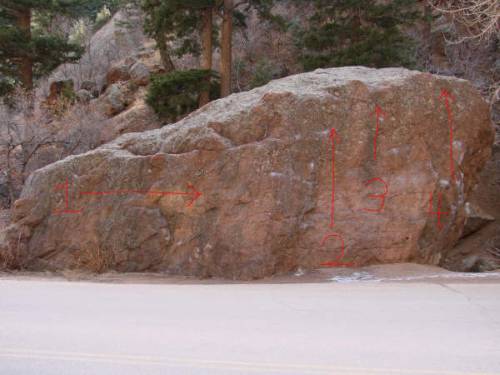
Graduating with Honors: Bouldering in Cheyenne Canyon
by Phil Wortmann
Location: 2 feet South of road (brutal approach!)
Difficulty: V-0 to V-Hard
Type of rock: Best granite in the park
Position: Snuggled in next to a cool mountain brook and sheltered by shade trees
Descent: Third-class walk off
These facts, known by locals for decades, make this chunk of granite a popular favorite. It was probably Army climbers who first climbed here seriously. Harvey T. Carter taught soldiers how to climb and correctly place pitons in “the Canyon” during the 1950’s. Harvey developed many projects here over the years, and was responsible for mapping many of the classic routes still sought after today. He also brought attention to the boulder by introducing top notch talent. One summer, Yosemite hardmen Yvon Choinard and Royal Robbins passed through the area and worked several problems here with him. They were impressed with the quality of the rock and spent several days working its problems.
Graduation Boulder remains a training ground after decades of use due to the multitude of options its subtle texture presents. Every time I think I’ve solved my last great problem here, I find myself confronted with a new, even harder one. Infinite variations exist for the adventurous and creative.
The list below is a collection of the basic routes found on the three main faces of the boulder. The names given here were chosen by myself, only to help direct climbers in identifying them. If someone is aware of the original name or FA’er, please post it below. Also, feel free to chime in on your opinion of the grading of these routes.
North Face (roadside)
1-HAND TRAVERSE 5.9 to V 10? Good way to build endurance. Begin at the walk off found at the North East corner of the boulder. Move right using the big rail on top, or the smaller holds down lower. First section is about 5.9, getting around the west side is probably V4 or 5, and the back side is definitely the crux. This traverse gets harder the further you go.
2-NORTH FACE/ SIT START V1 Start bottom left, use rail to gain higher holds. Top out left.
3-NORTH FACE/ STAND START 5.9 Climbs chipped holds to top center.
4-ARETE PROBLEM V2+ Start on left sloper and use sharp crimps to top.
West Side Story.
 5-GRADUATION CRACK 5.10+ The classic. Begins as standing start, gets harder as you get higher. Big horn on top.
5-GRADUATION CRACK 5.10+ The classic. Begins as standing start, gets harder as you get higher. Big horn on top.
6-GRADUATION CRACK/ ARETE FINISH 5.10+ Same start, lunge right to large pinch holds. Finish to right of horn.
7 -SOUTH ARETE V1 Start by gaining large hold in horizontal crack, then use slopers to traverse out over the arête. Top out on crystals.
8-SOUTH ARETE/ SIT START V3 The crux is probably getting off the ground on this one. Start with both hands liebacking and “pop” up. Use sloper horn to gain the horizontal crack around the corner. Finish on SOUTH ARETE.
South Face (creekside)
9-CRYSTALS V1 Start by liebacking the good right facing holds. Goes up from there with long reaches on sharp crystals.
10-HIGH START V4 Highball finish. Standing start on sloper right hand rail. Reach high left then continue straight up right on small crystals and pockets. Eases off a little up high.
 11-HIGH BULGE V2 Start at the base of left trending crack. Reaches high right to a descent hold, then up a couple moves to a jug. The crux on this one is the mental aspect of leaning back so far on a highball.
11-HIGH BULGE V2 Start at the base of left trending crack. Reaches high right to a descent hold, then up a couple moves to a jug. The crux on this one is the mental aspect of leaning back so far on a highball.
12-REACH AROUND V1 Short problem starting under the bulge and moving to great holds on top.
The post Graduating with Honors: Bouldering in Cheyenne Canyon appeared first on Mountain Chalet.

